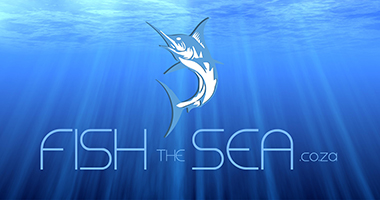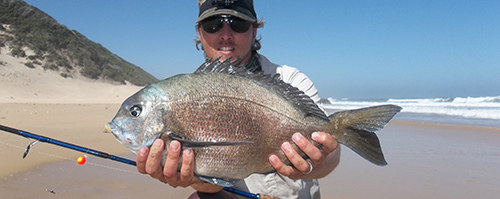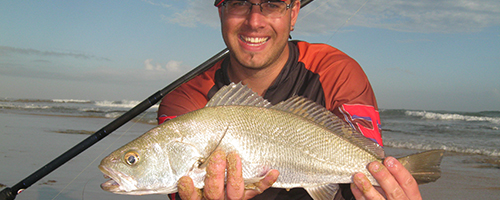Trolling Lures Inshore: Estuaries & Rivers; The Do's And Don'ts Of Trolling Lures
How To Troll Lures In South African River And Estuarine Systems Effectively
![]() Many anglers and fishermen all over South Africa fish the many great
saltwater river systems and estuaries we are lucky enough to have and most of
these anglers fish these rivers and estuaries to target species such as Kob,
Kingfish, Grunter and Steenbras. What people do not know is that trolling a lure
in a river or estuary system can be deadly and sometimes can produce more fish
or fish species than you would with bait. There are so many
saltwater fish you
can catch when trolling lures and it all depends on the size of the lure. Below
is all the information you need to know about how, when, why and what you need
to do when trolling lures, jigs, lead heads and other artificial baits in South
Africa's saltwater estuarine systems and rivers...
Many anglers and fishermen all over South Africa fish the many great
saltwater river systems and estuaries we are lucky enough to have and most of
these anglers fish these rivers and estuaries to target species such as Kob,
Kingfish, Grunter and Steenbras. What people do not know is that trolling a lure
in a river or estuary system can be deadly and sometimes can produce more fish
or fish species than you would with bait. There are so many
saltwater fish you
can catch when trolling lures and it all depends on the size of the lure. Below
is all the information you need to know about how, when, why and what you need
to do when trolling lures, jigs, lead heads and other artificial baits in South
Africa's saltwater estuarine systems and rivers...
What To Look For When Trolling In Rivers And Estuaries?
![]() The
best times to troll lures are early morning, before it gets too hot, and
late afternoon. Although in Winter good trolling can be done throughout
the day... When trolling for game fish in estuaries it is always a good
idea to drive around trolling lures and looking for places that look
promising... Because you have a lot better chance of catching fish with
your lures in the water! Fish are unpredictable and opportunistic, they
do not just hang around one drop off the whole time they move around and
when they move around they swim through shallower water and water with
no structure, so just keep that in mind...
The
best times to troll lures are early morning, before it gets too hot, and
late afternoon. Although in Winter good trolling can be done throughout
the day... When trolling for game fish in estuaries it is always a good
idea to drive around trolling lures and looking for places that look
promising... Because you have a lot better chance of catching fish with
your lures in the water! Fish are unpredictable and opportunistic, they
do not just hang around one drop off the whole time they move around and
when they move around they swim through shallower water and water with
no structure, so just keep that in mind...
When you do find a drop off, lots of structure, a sandbank or other areas that are different to the normal characteristics of the river you have probably found a great place to troll your lure. Other things to look out for are where calm water meets rough water, muddy water meets clear water and where there are mullet or other bait fish jumping out of the water or going crazy.
![]() Once
you have found a spot to troll your lures, it is all about finding the
best colour and size lure... It is good to troll an area you think holds
fish 5-6 times before moving on and if you catch a fish in the area it
will be good to troll a few more times. You should troll different lures
at different depths and see which ones produce on the day. If you troll
an area once you might miss the fish the first time, but if you troll it
back and forth a few times you will probably get hooked into a nice
fish... The fish you are targeting while trolling are naturally
aggressive and lures either annoy them or fool them into thinking it is
food so there is a good chance if a fish is in the area you are trolling
it will attack your lure.
Once
you have found a spot to troll your lures, it is all about finding the
best colour and size lure... It is good to troll an area you think holds
fish 5-6 times before moving on and if you catch a fish in the area it
will be good to troll a few more times. You should troll different lures
at different depths and see which ones produce on the day. If you troll
an area once you might miss the fish the first time, but if you troll it
back and forth a few times you will probably get hooked into a nice
fish... The fish you are targeting while trolling are naturally
aggressive and lures either annoy them or fool them into thinking it is
food so there is a good chance if a fish is in the area you are trolling
it will attack your lure.
What Lures To Use When Trolling In Rivers And Estuaries?
 In
my opinion there are only two types of lures to troll in estuary and
river systems... Hard plastic shallow divers and hard plastic deep
diving lures. A lot of anglers and fishermen do troll dropshot plastic
minnows, squids and bait imitations as well as jigs, spoons, lead heads
and buck tails. The dropshot lures are fine to troll but I have noticed
that the harder plastic deep diving lures are made for trolling and have
a great action and constantly produce fish. The trouble with trolling
spoons, buck tails, lead heads and jigs is that you can easily get
snagged up on the bottom and they do not have a very good trolling
action.
In
my opinion there are only two types of lures to troll in estuary and
river systems... Hard plastic shallow divers and hard plastic deep
diving lures. A lot of anglers and fishermen do troll dropshot plastic
minnows, squids and bait imitations as well as jigs, spoons, lead heads
and buck tails. The dropshot lures are fine to troll but I have noticed
that the harder plastic deep diving lures are made for trolling and have
a great action and constantly produce fish. The trouble with trolling
spoons, buck tails, lead heads and jigs is that you can easily get
snagged up on the bottom and they do not have a very good trolling
action.
 My
lures of
choice for trolling are hard plastics such as
Halco,
Rapala, Strike Pro, Sebile and Spro lures. And I am quite biased towards
Halco lures as I have caught many fish on them... The best size lures
for trolling in South African inshore locations are between 4
centimeters and 12 centimeters... 16 centimeter lures do work well but
only for fish large enough to take them. The size I like trolling with
is 8-10 centimeters. Its the perfect size lure for trolling in an
estuary and you will catch any size fish on it... From a 1 kilogram
Snapper to a 25 kilogram Kob. You will often find that lures catch fish
in estuaries bigger than the average size of the fish caught on bait.
My
lures of
choice for trolling are hard plastics such as
Halco,
Rapala, Strike Pro, Sebile and Spro lures. And I am quite biased towards
Halco lures as I have caught many fish on them... The best size lures
for trolling in South African inshore locations are between 4
centimeters and 12 centimeters... 16 centimeter lures do work well but
only for fish large enough to take them. The size I like trolling with
is 8-10 centimeters. Its the perfect size lure for trolling in an
estuary and you will catch any size fish on it... From a 1 kilogram
Snapper to a 25 kilogram Kob. You will often find that lures catch fish
in estuaries bigger than the average size of the fish caught on bait.
 Lure
colour choice in my opinion comes down to an anglers favourite colour.
Without a doubt the better colour lures are the ones with two
contrasting colours: Red and white, black and orange, green and gold and
pink and black... If I had to choose these would be the best colours for
estuary trolling:
Lure
colour choice in my opinion comes down to an anglers favourite colour.
Without a doubt the better colour lures are the ones with two
contrasting colours: Red and white, black and orange, green and gold and
pink and black... If I had to choose these would be the best colours for
estuary trolling:
- Red and white
- Dark green and gold
- Pink, white and black combinations
- Lumo green, orange, yellow
- Jelly prawn
- Sardine
- Mullet
- Multicolour
And as for lures if I had to choose these would be my favourites:
- Halco Sorcerer 90
- Halco Sorcerer 68
- Halco Laser Pro 45
- Halco Laser Pro 120
- Rapala X-Rap
- Rapala Shad-Rap
- Strike Pro Thunder Belly
- Strike Pro Titan
Small poppers between the sizes of 5 and 8 centimeters can be very effective when trolling sometimes and feathers (Saltwater flies) can also produce the goods. Stickbaits can also produce good fish in South African estuaries in shallow water.
What Fish Species Can You Catch When Trolling In Rivers And Estuaries?
![]() When you are trolling you never know what species of saltwater or
freshwater fish you might catch. But you can put the most likely you are
going to catch into a list: Springer, Kob, Garrick, Kingfish, Barracuda,
Shad, Snapper, Perch, Rockcod, Grunter, River Bream, Stumpnose, Mullet
and the list goes on... Almost any estuarine fish species in South
Africa will take a lure, whether it is a soft plastic, a hard plastic or
a bucktail, fish are opportunistic and if they think the lure is a
vulnerable food item or they feel threatened/annoyed by the lure they
will attack it, which should (Most of the time) give you a solid hook
up. There are so many
saltwater fish
species that breed in estuarine and river systems so the chances of
catching almost any type of fish are there...
When you are trolling you never know what species of saltwater or
freshwater fish you might catch. But you can put the most likely you are
going to catch into a list: Springer, Kob, Garrick, Kingfish, Barracuda,
Shad, Snapper, Perch, Rockcod, Grunter, River Bream, Stumpnose, Mullet
and the list goes on... Almost any estuarine fish species in South
Africa will take a lure, whether it is a soft plastic, a hard plastic or
a bucktail, fish are opportunistic and if they think the lure is a
vulnerable food item or they feel threatened/annoyed by the lure they
will attack it, which should (Most of the time) give you a solid hook
up. There are so many
saltwater fish
species that breed in estuarine and river systems so the chances of
catching almost any type of fish are there...
How To Catch, Land And Release The Fish...
Fish conservation is very important in South Africa, so please handle the fish you catch with care and try and release them for the future generations to enjoy.
 When
you start off trolling a normal figure of 8, Rapala or improved clinch
knot should be tied to your lure... I would use 20 pound fluorocarbon
leader attached to 15-18 pound Double X mainline with a leader not or a
swivel. A 6-7 foot rod with a bit of backbone will be perfect for this
type of trolling with a size 4000 coffee grinder reel. Then you are
ready let your lure go out behind the wake of the boat, set your drag
quite loose and then place your rod in the rod holder or hold the rod, I
prefer to hold the rod when trolling.
When
you start off trolling a normal figure of 8, Rapala or improved clinch
knot should be tied to your lure... I would use 20 pound fluorocarbon
leader attached to 15-18 pound Double X mainline with a leader not or a
swivel. A 6-7 foot rod with a bit of backbone will be perfect for this
type of trolling with a size 4000 coffee grinder reel. Then you are
ready let your lure go out behind the wake of the boat, set your drag
quite loose and then place your rod in the rod holder or hold the rod, I
prefer to hold the rod when trolling.
When a fish takes your lure, it will either miss the lure completely or it will get hooked. Tighten up the drag and strike to ensure the hooks are set. And then keep the pressure on the fish, but when it wants to take line, let it take line.
 Once
you have got the fish close to the boat it is time to land it... It is
best to land the fish with a net, wet your hands and remove the hooks...
If you want to take picture it is good to make sure the floor of the
boat is wet or you have a large wet towel or cloth to place the fish
on... Then wet your hands and hold the fish. It is important to wet your
hands as many game fish species have a layer of mucus on their skin
which protects them from parasites and disease. They are very vulnerable
if this is removed.
Once
you have got the fish close to the boat it is time to land it... It is
best to land the fish with a net, wet your hands and remove the hooks...
If you want to take picture it is good to make sure the floor of the
boat is wet or you have a large wet towel or cloth to place the fish
on... Then wet your hands and hold the fish. It is important to wet your
hands as many game fish species have a layer of mucus on their skin
which protects them from parasites and disease. They are very vulnerable
if this is removed.
Then when releasing the fish, hold the fish in the water with its head pointing in the direction of the current. This will revive the fish. Hold it firmly and only release it when it is strong enough to swim out of your hands.
Trolling is a great way to catch fish species and it is very enjoyable... I hope this article on trolling the rivers and estuaries of South Africa will help you catch more fish... Tight Lines...
Read more about the basics of lure fishing here...








